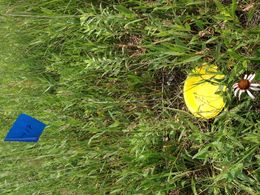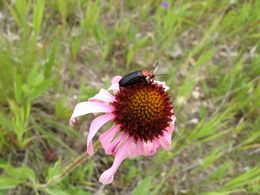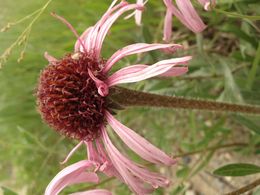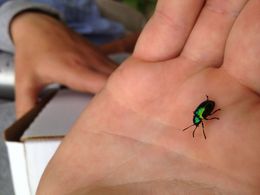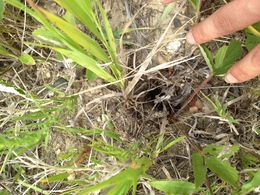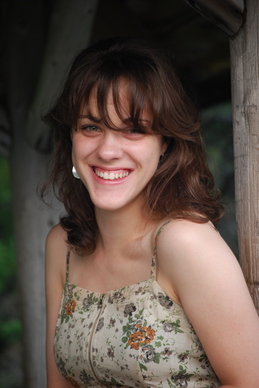|
|
Despite the heat and humidity, Friday was yet another productive field day for Team Echinacea.
This morning everyone worked on their individual projects. Since my pitfall traps are ready to go, Greg and I placed pollinator traps on different prairie remnants. Pollinator traps are these nifty –and apparently hard to come by– yellow bowls that you fill with soapy water. Traveling from remnant to remnant, we also discovered that there’s a giant hole where the landfill prairie remnant used to be…

Later this morning, equipped with buckets as chairs, Greg and I headed up to one of the hills around Hegg Lake to observe some large soil-nesting bees. After an hour of watching, we saw two bees land in different holes, but no bees emerge. We’re not sure whether these bees are solitary or eusocial.
I also scored some pictures of the arthropod life on Echinacea heads.


  
Here is the “fuzzy” Echinacea head from the Kittleson roadside. Echinacea styles typically shrivel when successfully pollinated and persist when unpollinated or pollinated with incompatible pollen. In the case of this poor plant, the “fuzziness” is caused by all of the styles persisting, indicating that this plant hasn’t been successfully pollinated yet.
 
After lunch, the team trekked out to the common garden (C1) to measure Echinacea that had been planted in previous years. Measuring each plant year after year gives us a sense of the fitness of the individuals. We recorded things like the number of basal rosettes, number of basal leaves, as well as the length of the longest leaf, insect presence, among a slew of other characteristics.
Greg and I took off a bit early from measuring to go collect the pollinators from the traps we set out earlier in the morning. Also, Shona made a beetle friend! We’re still trying to figure out what exactly this little guy is and I’ll post it once we figure it out.

I realize that most of these pictures are sideways and I don’t know how to fix it at the moment. All of them were rotated the right way when I uploaded them…go figure.
With the help of Andrew and Kelly, I finished setting up all of my pitfall traps for my ant survey today–a grand total of 12 5x30m plots and 144 pitfall traps! I started on Monday with Katherine, setting up Nessman, the smallest of my sites. We quickly learned that digging holes with the soil core sampler is much more efficient when we have some sort of sharp object to dislodge soil from the sampler & that having a dibbler to pre-form holes speeds up the process.



On Tuesday Katherine, Lydia, Kelly, and I set up the plots on East Elk Lake Road, Northwest Landfill, and North Northwest Landfill. Today Andrew, Kelly, and I braved the ticks out in Staffanson prairie preserve, knocking out the final 4 plots, 2 on the east unburned side and 2 on the west burned side.



To give the disturbed areas some time to settle, I’m leaving my traps capped until next week, after which I’ll collect specimens weekly and get cracking on ID-ing. For more details about why I’m doing what I’m doing, see my proposal.
Also, a brief protocol for setting up and collecting from my pitfall traps is below:
Pitfall Trap Procedure.pdf
Here’s my summer project proposal explaining my work with the ants in the prairie. I still need to tighten up the methods a bit, so keep an eye out for updated versions!
JG_REU Project Proposal 2012.pdf
Hi! I’m Jill and I’m from Sewaren, New Jersey–exit 11 off the turnpike, in the heart of oil refineries and old factories. Sick of the polluted air and lack of wilderness, I fled home for Bar Harbor, Maine to attend College of the Atlantic (COA), a tiny liberal arts school tucked away on the coast of Mount Desert Island. There I study Human Ecology along with every other student– a one-major curriculum allowing every student to independently design his or her own course of study. Entering my senior year this fall, I’ve spent my time at COA studying the relationships between soils, plants, and arthropods on contaminated and other ecologically “harsh” sites–sites distinguished by xeric, nutrient-poor, nutrient-imbalanced soils laced with high levels of heavy metals. I’ll be completing my undergraduate thesis “Diversity and metal content of arthropods on adjacent serpentine and granite outcrops on Deer Isle, ME” this year, hopefully with a manuscript in the works.
Here with The Echinacea Project, I plan to study the ant communities on the prairie remnants and the prairie preserve to provide baseline data for further projects on the ants of the prairie. Like Shona, I’ll post my project proposal on here once it’s polished…
I’m looking forward to the rest of the summer packed with fulfilling fieldwork, great experiences, and wonderful people!

|
|
